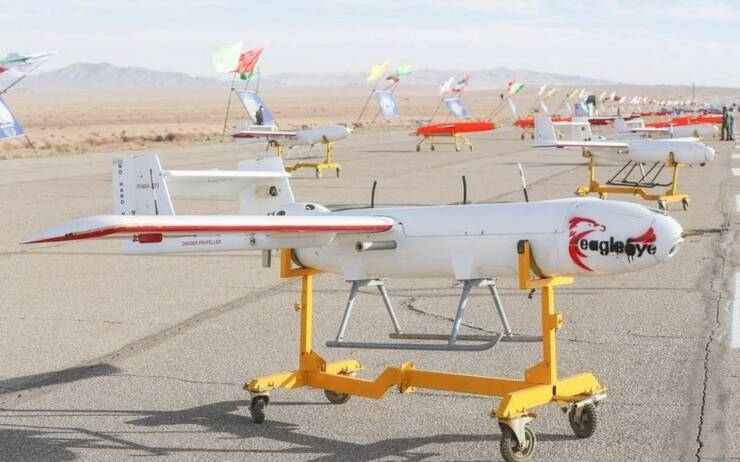
Tel Aviv. A unified military action against the Iranian armed drones is underway. The US, Britain and Israel have started to implement the decision to act together against the threat posed by the Iranian armed drones, operated mainly by the Houthi rebels in Yemen. Elite units arrived at Yemen in an effort to hunt the Houthi rebels that operate the deadly UAV’s. The details of the operation were first reported by the British media.
In Israel no one was available to comment on these reports. Ten years ago, the Israeli defense forces (IDF) decided to form the “Depth Command” which is responsible for Israeli military operations “far from the Israeli borders”.
There are no details on the classified unit but Israeli sources said that it is equipped and trained to “hit far and strong”.
The current operation is a result of a discussion between the US and Israel. The mutual concern has been discussed in Israel and the US in recent weeks. American and Israeli experts met two months ago to discuss the ways to deal with the growing threat. In late April, White House national security adviser Jake Sullivan and Israeli national security adviser Meir Ben-Shabbat agreed to establish an interagency working group to focus attention on the growing threat from the Iranian made armed UAV’s.
According to a report prepared by the Israeli Institute for National Security Studies (INSS), the main fire power of the Houthi rebels is their Iranian made armed UAV’s, either armed with bombs for air-to-ground strikes or used as loitering munitions. According to the two senior researchers Ari Heistein and Elisha Stoin, the Houthis have an extensive arsenal of UAVs, including long-range Samad models. The group used Samad UAVs for long-range attacks in 2018 (Abu Dhabi) and then again in 2019 (Riyadh). However, the Samad-3, which claims an operational range of 1,800 km – theoretically enough to conduct attack on Israel – will have limited ability to inflict damage on Israeli infrastructure, given its 45 kg warhead.
The researchers say that in March 2021 the Houthi military industries unveiled a Samad-4 model it claims has a range of 2000 km and is capable of delivering two small rockets. At the same event, the Houthis presented the Wa’id UAV which appears to be a loitering munition with a declared range of 2500 km. “These latest developments indicate a potential leap forward in the Houthi arsenal of weapons capable of striking Israel.” While the Houthis have not yet used their armed UAV’s to attack Israel, they performed some attacks on Israeli owned cargo ships. The last one claimed the lives of two crew members.
According to the British Express website, 40 strong team of SAS soldiers arrived in eastern Yemen yesterday.
“Landing at Al Ghaydah airport in Mahra, they are said to be using local handlers, who have knowledge of the region to help hunt the Houthi mercenaries responsible. The team also includes a specialist -electronic ¬warfare unit which can deploy resources to hoover up communications chatter.”
The British daily says that it is feared Tehran supplied the militants with the long-range unmanned aerial vehicle (UAV), to threaten international merchant vessels in some of the world’s ¬busiest shipping lanes. “US-Israeli intelligence believe the drone was launched from ¬eastern Yemen and directed by GPS towards the tanker before an operator took control for the final mile, directing the rocket via camera into the ship’s bridge.” The report claims.
According to the British media report British, American and Israeli intelligence experts who examined the fragments of the Iranian UAV’s used to hit the Mercer Street was came to the conclusion that they were launched from eastern Yemen.
The INSS report says that as Israel is 2,000 km from the Houthis’ main operational theatre, launching a long-range attack while overcoming Israel’s early warning intelligence and defensive capabilities would likely prove a rather difficult task.” It demands a unique force build-up effort by the Houthis that exceeds their existing capabilities. In addition, if the Houthis are thinking one step ahead, they will likely also understand the need to acquire in advance the capabilities to fend off a long and intensive Israeli response.”
But Israeli sources said that while a direct attack by armed UAV’s on Israel is not a real threat, the threat posed by the armed UAV’s to Israeli “assets” is very imminent. The sources added that while Israeli owned cargo ships may be targeted again, there are other Israeli “assets” that can be targeted. The sources were reluctant to be specific, but it can be understood that some of the potential targets can be Israeli “operations” in the Gulf States that have recently signed normalization agreements with Israel.
-The writer is an International Roving Correspondent of the publication.








